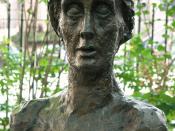Gender Roles and Conflicts Expressed in Virginia Woolf's To the Lighthouse
Time and time again, gender-conflict has continued to be a focal issue. Since the beginning of time, this dilemma has been articulated through novels or other various forms of writing. It is now brought to the public's attention in forms such as the news, radio and the workplace. Habitually asked, are the age old questions of: "what is a man's place in society?", "what is a woman's place in society?", or "is there a specific place for either?" Furthermore, "is there a genuine difference at all?" One critic explains, "Woolf reaches beyond personal relationships to explore man's wider relation to the Universe" (McNichol 1). In Virginia Woolf's novel, To the Lighthouse, the differences in male and female roles are a reoccurring theme that is ultimately answered by one character in her final days at the Ramsey's home.
One of the central motifs in To the Lighthouse is the conflict between the feminine and masculine principles at work in the universe. "Within this symbolic framework Woolf probes the profound tensions at the core of all relationships between men and women" (McNichol 1). Two of the main characters that show the opposing sides are Mr. Ramsey, a self centered philosopher who feels that the duty of women is to cater to the needs of men, and Mrs. Ramsey, an emotional, old fashioned woman. Their flaws consist of their limited views and beliefs. The key factor in Woolf's novel is a character by the name of Lily Briscoe. She is a painter and friend of the family, who vacations at their home each summer. With her perspective on life, she thins out the line between male and female. Not only does this character show the ideal role of male/female in...



Well done!
This is a well organized and well explored essay. It sounds very convincing with all the examples & evidences for each point. The ideas are also organized logically.
0 out of 0 people found this comment useful.